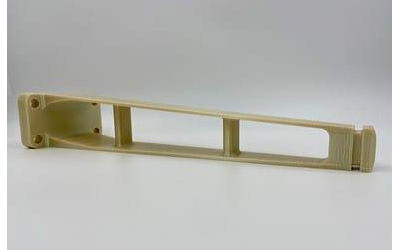Hexagon and Stratasys Partner to Provide Design-to-3D-Print Virtual Simulation Software for Aerospace Applications
The two companies will be combining their technologies to reduce part lead time for 3D-printed aerospace parts.

An aircraft ventilation duct geometry used for process simulation development. (Image courtesy of Hexagon’s Manufacturing Intelligence division.)
Hexagon’s Manufacturing Intelligence division revealed that it will be collaborating with 3D printer and 3D production systems developer Stratasys to provide a new software solution for aerospace applications. The two will be combining their technologies to provide advanced virtual engineering and manufacturing support to customers. This is expected to significantly reduce the time factor of designing by two to three years, as well as reduce testing time by approximately two quarters of a year. According to the two tech companies, their objective is to boost confidence in the performance and safety of 3D printer plastic components while simultaneously compressing time to market.
“The aerospace industry is continuously pushing the boundaries of performance and innovation, but current confidence in the performance of additive manufactured parts is mostly limiting its application to highly specialised metal parts,” shared Guillaume Boisot, head of ICME at Hexagon’s Manufacturing Intelligence division.
Users of Stratasys’ ULTEM 9085 filament will now be able to access Hexagon’s Digimat material modeling software, which lets manufacturers estimate the performance of printed parts. This means that users can predict how printed parts will most likely behave mechanically when created with Stratasys’ printers.
According to Stratasys, ULTEM 9085 resin is a high-performance thermoplastic with a high strength-to-weight ratio, excellent heat resistance, and high impact strength, and it possesses favorable flame, smoke, and toxicity (FST) characteristics. ULTEM 9085 resin is typically used in building aircraft interior parts, including bracketry, cable routing pieces, and cover and duct components. These parts are required to meet stringent certification for aspects such as flammability and toxicity.
By integrating the use of Hexagon’s material modeling software, engineers and designers will be able to leverage the software’s process simulation capabilities to identify defects such as delineation of warpage of a part. This is made possible via a highly accurate virtual material model that contains detailed information about the material’s internal microstructure. It can also analyze the print time and material cost for the proprietary printer tool paths of machines to ensure optimized results. The process has been dubbed by Hexagon as “virtual manufacturing.”
Aside from increased confidence, some other benefits that aerospace engineers can expect include faster speed to market. The Digimat can reduce the number of physical prototype iterations required for testing. This not only compresses time to market but also accelerates product innovation. In addition, engineers will be able to gain an enhanced understanding of which material properties work best for certain complex geometric parts. Traditional processes typically involve time-consuming and expensive testing, which mainly rely on datasets that are based on the destructive testing of material coupons rather than real part geometries.
“The dual needs to make complex parts lighter and produce low volumes economically has meant that aerospace has pulled 3D printing towards production and put the sector ahead of the curve in use of the technology. But this also means it’s the first industry to identify several challenges, a key one being the need for a digital toolset to provide confidence in 3D printed parts,” shared Scott Sevcik, vice president for Stratasys’ Aerospace Business Segment. “Our partnership with Hexagon is a big step forward in solving that, as it gives engineers the same upfront design intelligence for 3D printing that they have for traditional processes.”
For more information on virtual manufacturing, visit Hexagon’s official website.








